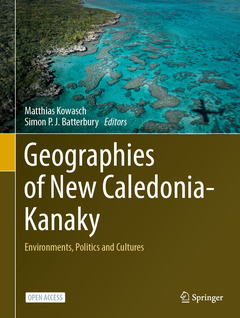Description
Geographies of New Caledonia-Kanaky, 1st ed. 2024
Environments, Politics and Cultures
Coordinators: Kowasch Matthias, Batterbury Simon P. J.
Language: English
Subjects for Geographies of New Caledonia-Kanaky:
Keywords
Geography of Kanaky; Economic Development in New Caledonia; Biodiversity and Environmental Protection in the South Pacific; New Caledonian Independence Referendum; French Colonial History; Decolonization and Indigenous Studies; Spatial Disparities and Rural Development in New Caledonia; Environmental Protection and Biodiversity; Climate Change in the South Pacific; Extractive Industries and Mining Development; Social Transformations and Ethnic Disparities; Island Tourism; Open Access
283 p. · 21x27.9 cm · Hardback
Description
/li>Contents
/li>Biography
/li>Comment
/li>
This open access book provides a unique overview of geographical, historical, political and environmental issues facing the French overseas territory New Caledonia, also called ?Kanaky? by the indigenous Kanak people, who outnumber citizens of European and other origin. New Caledonia has seen a long and complex struggle for decolonization, but is still on the United Nations? list of ?Non-Self Governing territories? and there is little sign of change following three referendums on independence and extensive negotiations with France. The archipelago possesses around a quarter of the world?s nickel deposits, giving it additional strategic importance when demand for the mineral is strong. The islands have unique biodiversity, and Caledonian coastal lagoons have been listed as UNESCO world heritage sites since 2008. The book offers detailed insights into the environmental and human geographies of the archipelago, with a focus on the linksbetween environmental protection and extensive mining operations, between political independence struggles and continued wellbeing and economic development, and the differing visions for the future of the islands. This multidisciplinary volume, one of the few to appear in English, appeals to researchers, students and policy makers across the environmental, social and political sciences.
Introduction.- Part I: Environmental protection and biodiversity: Chapter 1: Which environmental policies for New Caledonia?.- Chapter 2: What makes New Caledonia’s flora so outstanding?.- Chapter 3: Marine biodiversity in New Caledonia in relation to conservation challenges.- Part II: Fisheries and agriculture: Chapter 4: Small-scale fisheries in New Caledonia: towards a fishers’ perspective.- Chapter 5: “Fortunately, I have my field”: changes and permanencies in Kanak family farming.- Part III: Extractive industries, mining development and waste management: Chapter 6: Waste level rise? Scales, spaces, and policies of waste in New Caledonia.- Chapter 7: Conflicts and legitimacy of environmental organizations facing mining projects in New Caledonia-Kanaky.- Chapter 8: Decolonization process without independence in the light of changes in the nickel sector in New Caledonia.- PartIV: Land reform and urban development: Chapter 9: Land reform, conflict and local development on “Grande Terre”.- Chapter 10: Has “White Nouméa” become more Kanak?.- Chapter 11: Kanak cultural heritage on colonised and damaged lands.- Chapter 12: What future for Kanak Languages? Size and geographic distribution.- Chapter 13: Transforming Kanak knowledge to teach students and train teachers in New Caledonia.- Chapter 14: Gender, politics and power in New Caledonia.- Chapter 15: The emergence of an autonomous political arena in Ouvéa: an ethnography of its local council .- Chapter 16: Indigenous rights or national independence? Paths of self-determination in New Caledonia.- Chapter 17: New Caledonia’s self-determination process.- Chapter 18: A critical reflection of the notion of “common destiny” in Kanaky-New Caledonia.- Chapter 19: The citizenship dilemma in decolonising New Caledonia.- Chapter 20. Conclusion.
Matthias Kowasch is a human geographer, Professor of Didactics in Geography and Economics at the University College of Teacher Education Styria, Austria, and currently Professor II at Inland Norway University of Applied Sciences.
Simon P.J. Batterbury is a human geographer, Professor of Environmental Studies at the University of Melbourne, and convenor of the doctoral training program, the Melbourne Climate Futures Academy.



